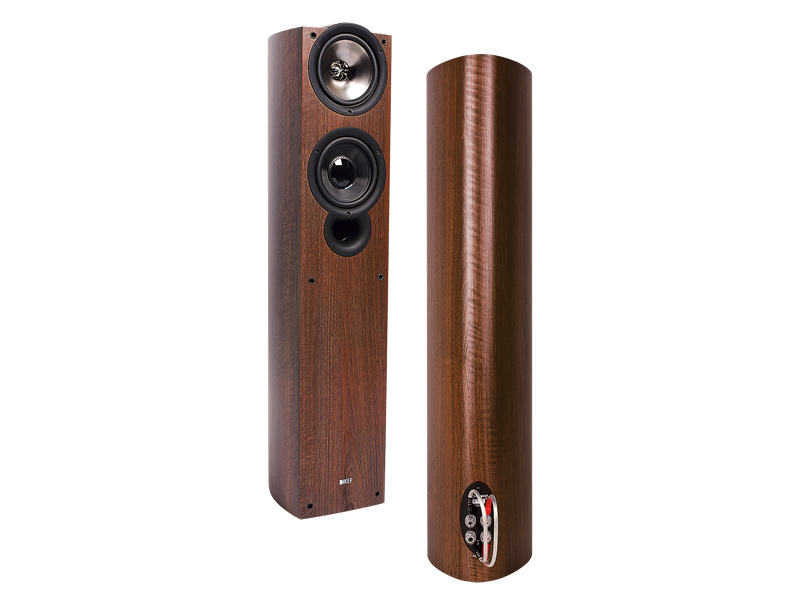TechRadar Verdict
Cutely styled and beautifully discreet, this latest Uni-Q has attractively spacious imaging, good overall balance, a sweet treble and fine consistency. Ultimately the bass lacks real authority and dynamic behaviour is weak
Pros
- +
Fine spacious imaging
- +
Sweet treble
- +
Good consistency across a large zone
- +
Fine overall tonal balance
Cons
- -
Although the overall balance is respectable, the midband is a little over-projected
- -
Bass lacks tension and grip
Why you can trust TechRadar
This latest iQ range from KEF has added a zero to the model numbers that were used for its predecessors.
Of the five stereo pairs, supplemented by a couple of partnering home cinema extras, this £499 per pair KEF iQ50 is the middle model.
It's the smallest of three floorstanders and is an unusually attractive and compact example of the type, thanks to a combination of 130mm Uni-Q driver for bass, midrange and treble with an extra 130mm bass-only driver, both sharing the same front-ported enclosure. Shaped foam bungs are supplied to block these ports if desired.
Unusually attractive design
The back and sides of the enclosure are formed into a continuous curve, tightening at the back, which not only looks unusually attractive, but should also improve overall stiffness and avoid focusing the internal lateral standing waves. The front panel too is very gently curved.
At the standard price the enclosure comes finished all over in a choice of walnut, dark apple, or black ash vinyl woodprint (real wood veneered light oak and walnut are available at extra cost). A moulded black 'bump' covers much of the top surface, matching the curve of the Uni-Q driver frame.
The twin terminal pairs themselves seemed a little reluctant to tighten and stay tightened, but they come connected by wire links, which are certainly preferable to the brass strips almost universally used elsewhere.
Speaker alignment
Positioned in free space, well clear of walls, the far-field, averaged in-room measurements show a dry bottom end alignment, even with the ports entirely unobstructed. A little judicious closer-to-wall assistance might well be worth trying here, but the bungs should only be used if the speaker has to be sited very close to a wall.
The port tuning frequency of 45hz gives good ultimate in-room extension down to around 23hz, though the bottom end might have been smoother.
Sensitivity matches the specified 88dB, a healthy figure for such a small speaker, especially given the good bass extension and an amplifier load that stays above five ohms throughout. The pair match of our samples looked pretty good, though the impedance traces do show several resonant perturbations, most obviously at 180hz and 33hz, but also at 750hz and 1.2khz.
The overall frequency power response (in-room, far-field) holds within good +/-4dB limits right across the band, from 40hz to above 15khz, which is impressive enough, but the trend is not without a degree of unevenness, showing some prominence around 150-200hz and 750hz-1.25khz which is bound to be reflected in the sonic character.
Uni-Q advantages
Small speakers always have some inherent advantages and this iQ50 has a lovely spacious quality, with fine imaging and a decent measure of transparency, too.
Furthermore, the advantages of the Uni-Q driver are immediately apparent in the way the sound stays entirely – almost uncannily – consistent, not just with small head movements, but also as one stands up and moves around a decent size listening zone.
The treble improvements do seem to be effective, as this element in the overall performance seemed seamlessly integrated, very well judged and tolerably sweet. The midrange was rather less happy: although there was no obvious boxiness or significant nasality, speech did seem a trifle over-projected and voices had a touch of 'cupped hands' coloration.
Sluggish speaker
Not too surprisingly, the bass end is not its forte. While it certainly does go down to a respectably low frequency, it's a bit dry and lack lustre, punctuated by the occasional interjection of port thump. Not the most convincing qualitatively, it lacks dynamic grip.
Weak dynamic performance is really this speaker's nemesis, as it all too easily robs music of much of its tension and vigour, and consequently its interest. Although not slow in a time-smeared sense, this also seems to make the speaker sound a bit sluggish and lazy.
There is much to commend this speaker, however – it's attractive and discreet and the latest Uni-Q driver brings notable advantages. While it enjoys the usual benefits of a small loudspeaker, the KEF iQ50 also suffers from the limitations of the breed in its lack of authority.
